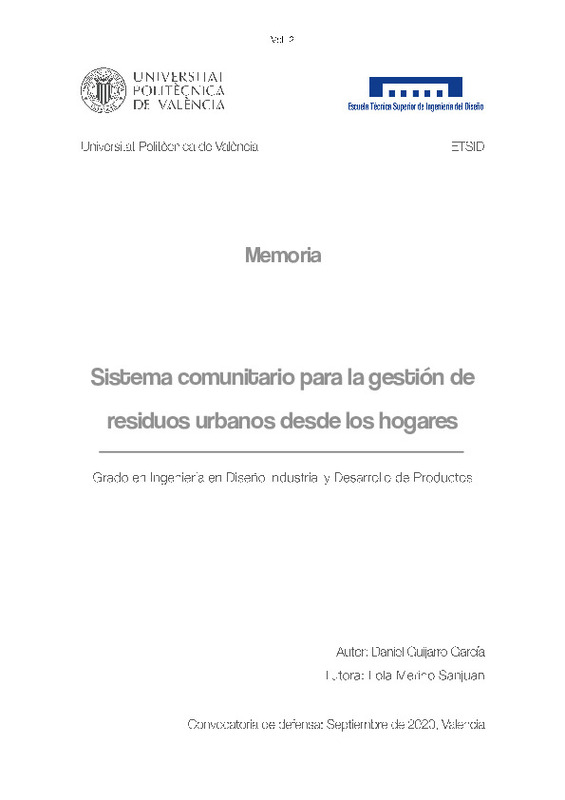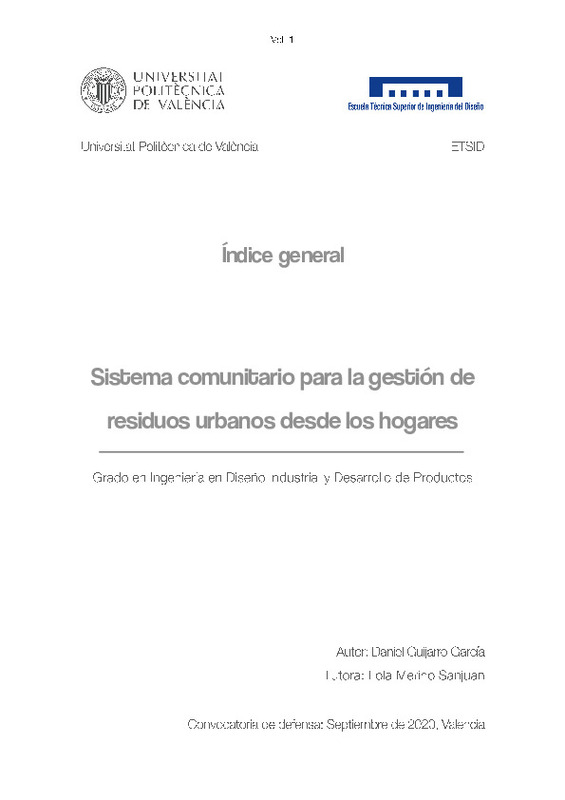|
Resumen:
|
[ES] El proyecto desarrolla una forma de reciclaje cercana al usuario. Para ello se propone que los hogares sean el primer punto de recogida (e
información) de, al menos, los principales tipos de residuos, incluido en ...[+]
[ES] El proyecto desarrolla una forma de reciclaje cercana al usuario. Para ello se propone que los hogares sean el primer punto de recogida (e
información) de, al menos, los principales tipos de residuos, incluido en el sistema general de gestión de residuos, de manera que las tareas de reciclaje no dependan de una cuestión de voluntad, sino de accesibilidad, permitiendo así una gestión de los residuos mucho más participativa y, por tanto, eficiente.
Para ello, este proyecto se va a enfocar en diseñar el elemento de conexión entre los hogares y los contenedores comunitarios (los que hoy entendemos como primer lugar de
recogida de residuos), pero que, como está ocurriendo en muchas ciudades, deberían pasar a ubicarse, en su mayoría, en los cuartos de basuras de los edificios. Dicha conexión será una canalización, que deberá adaptarse a las diferentes condiciones arquitectónicas, por lo que el diseño del elemento de conexión va enfocado a adaptarse a las necesidades de gestión de los hogares tratando de reducir en lo posible los costes espaciales y económicos que supongan la creación de estas canalizaciones.
Además, incluye un sistema de medición que permitiría registrar la cantidad de residuos desechados por cada hogar, edificio, distrito, ciudad , permitiendo observar concentraciones,
tendencias, necesidades y demás datos que pudiesen ser de interés para establecer planes de acción, limitaciones,...
[-]
[EN] This Project aims to bring the recycling tasks closer and more directly to the citizens, so it poses homes as the first waste collection (and information) points, at least, for the main types of residues included in ...[+]
[EN] This Project aims to bring the recycling tasks closer and more directly to the citizens, so it poses homes as the first waste collection (and information) points, at least, for the main types of residues included in the general waste management system, so that recycling tasks would not depend on individual attitudes but on accessibility, allowing a residues management quite more participative and, because of that, effective.
In order to achieve this objective, the project is focused on the design of the connection element between homes and community containers (currently, the first waste collection points), relocating most of these containers, as it already happensin many cities, in the buildings wastes room. This connection would be a canalization designed and adapted to the different architectonical conditions so that the design of the connecting element will be focused on being adaptative to the homes wasting necessities and, at the same time, trying to reduce as much as possible the spatial and economic costs of the potential canalization construction.
This element also includes a measurement system for residues, which would allow for the recording of the amount of residues produced by each home, building, district, city , thus permitting experts to analyze concentrations, trends, necessities and other interesting data, a valuable information which could lead to the implementation of more effective action plans,
limitations, ...
[-]
|








